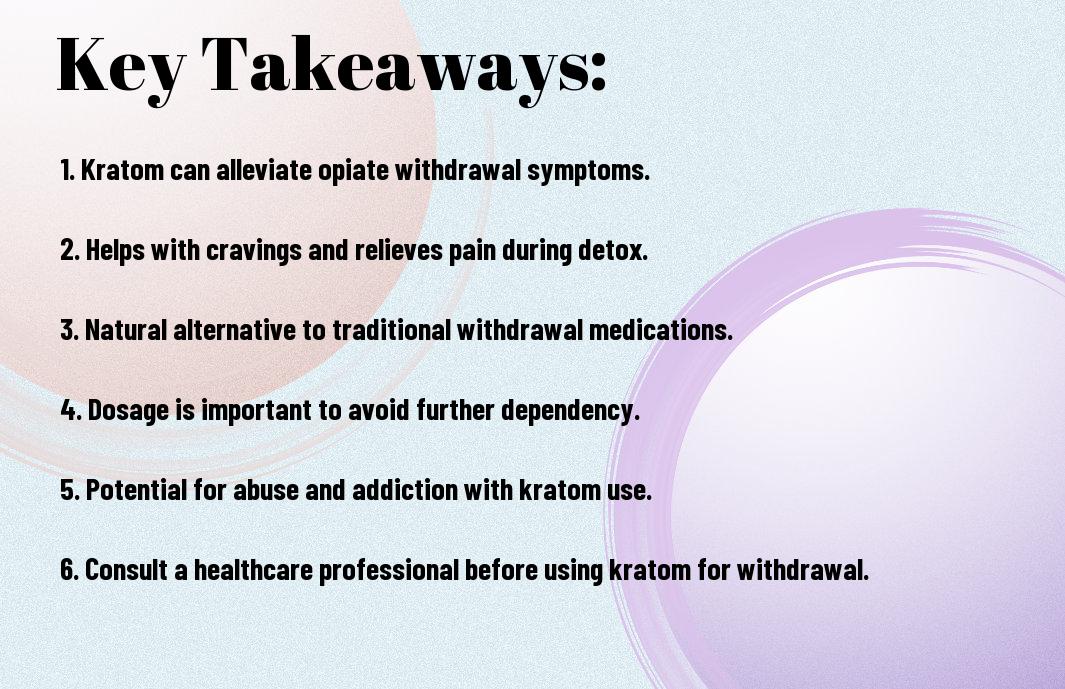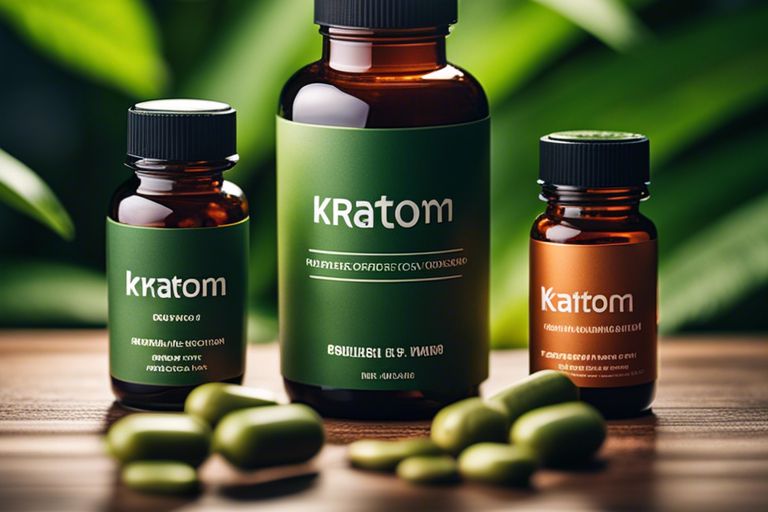It’s no secret that opioid withdrawal can be a harrowing experience for those struggling with addiction. However, there is a natural remedy that is gaining popularity for its potential to ease the symptoms of opiate withdrawal. In this article, we investigate into the world of kratom, a plant native to Southeast Asia that has been used for centuries for its medicinal properties. Learn about how kratom works, its safety profile, and its potential benefits for those looking to break free from the grasp of opioid addiction.
Key Takeaways:
- Kratom can help alleviate opiate withdrawal symptoms: Kratom is believed to help with opiate withdrawal symptoms due to its similar properties to opioids, which can help manage the side effects of withdrawal such as pain, anxiety, and cravings.
- It may have potential risks and side effects: While kratom may offer benefits for opiate withdrawal, it is important to be aware of potential risks and side effects, including addiction, dependence, and adverse reactions such as nausea, dizziness, and increased heart rate.
- Consult a healthcare professional before use: Before considering kratom as a treatment for opiate withdrawal, it is crucial to consult with a healthcare professional to discuss individual health conditions, potential drug interactions, and appropriate dosages to ensure safe and effective usage.

What is Kratom?
To truly understand how kratom can help with opiate withdrawal, it’s necessary to grasp what kratom is and its chemical makeup. Originating from Southeast Asia, kratom is a tropical tree in the coffee family known as Mitragyna speciosa. The plant’s leaves have been used for centuries by indigenous populations for their medicinal and stimulant properties.
Origin and History
Originating in countries like Thailand, Indonesia, Malaysia, and Papua New Guinea, kratom has a rich cultural history. It has been traditionally consumed by farmers and laborers to combat fatigue, increase productivity, and alleviate pain.
Chemical Composition
Kratom contains over 40 compounds and more than 25 alkaloids, with mitragynine and 7-hydroxymitragynine being the most prevalent and potent. These alkaloids interact with the body’s opioid receptors, producing analgesic and euphoric effects similar to opiates.
Opiate Withdrawal
Clearly, when individuals decide to stop using opiates, they may experience withdrawal symptoms. According to the Mayo Clinic, kratom has been suggested as a remedy for opioid withdrawal symptoms. There is debate within the medical community regarding the efficacy of kratom for this purpose, and further research is needed to fully understand its potential benefits and risks.
Symptoms and Effects
Symptoms of opiate withdrawal can range from mild to severe and may include anxiety, depression, muscle aches, nausea, vomiting, diarrhea, and insomnia. These symptoms can be extremely uncomfortable and challenging to manage without proper support and treatment.
Challenges of Quitting Opiates
The challenges of quitting opiates can be daunting, as the process can be physically and mentally taxing. Withdrawal symptoms can be severe, leading individuals to relapse in an attempt to alleviate the discomfort. It is crucial for individuals seeking to quit opiates to have a strong support system in place and access to medical assistance to help them safely navigate the withdrawal process.
Opiate withdrawal is a complex and difficult experience that requires patience, determination, and professional guidance. It is important for individuals struggling with opiate addiction to seek help and explore all available treatment options to ensure their journey to recovery is as safe and effective as possible.
How Kratom Helps with Opiate Withdrawal
Unlike traditional pharmaceutical medications, kratom offers a more natural approach to managing opiate withdrawal symptoms. Its active compounds interact with opioid receptors in the brain, providing relief without the same risk of dependence or respiratory depression as opiates.
Mitigating Withdrawal Symptoms
Symptoms such as nausea, muscle aches, and anxiety can be significantly alleviated with the use of kratom during opiate withdrawal. Users have reported feeling more comfortable and better able to cope with the challenging effects of quitting opiates.
Reducing Cravings
Mitigating the intense cravings that often accompany opiate withdrawal is crucial for successful recovery. Kratom has shown promise in reducing these cravings, making it easier for individuals to resist the temptation to relapse.
Kratom interacts with the brain in a way that helps to restore balance and reduce the fixation on opiates, leading to a higher likelihood of long-term abstinence.
Managing Pain
Managing the physical pain that accompanies opiate withdrawal is crucial for a smooth recovery process. Kratom’s analgesic properties can help individuals cope with the discomfort, making it easier to focus on their journey towards sobriety.
Another benefit of using kratom for pain management during opiate withdrawal is that it comes with fewer side effects compared to traditional painkillers, offering a safer alternative for those seeking relief.

The Science Behind Kratom’s Effectiveness
After Study Pokes Holes in Kratom’s ‘Bad Rap’, it’s important to understand how kratom interacts with the body to potentially aid in opiate withdrawal.
Opioid Receptors and Kratom
Kratom’s key compounds, mitragynine and 7-hydroxymitragynine, are alkaloids that bind to the same receptors in the brain as opioids, such as morphine and codeine. However, kratom’s interaction with these receptors is much milder and less dangerous than traditional opioids. This is why many individuals use kratom as a safer alternative to manage withdrawal symptoms.
Studies on Kratom’s Efficacy
Opioid withdrawal symptoms can be debilitating, making it challenging for individuals to break free from addiction. Studies have shown that kratom may help alleviate withdrawal symptoms by reducing pain, anxiety, and cravings. While more research is needed, the preliminary findings suggest that kratom holds promise as a potential treatment for opiate withdrawal.
Understanding the science behind kratom’s effectiveness is crucial in exploring its potential benefits for individuals struggling with opiate addiction. By targeting opioid receptors in a safer and milder way, kratom may offer a natural alternative for managing withdrawal symptoms and supporting recovery.
Using Kratom for Opiate Withdrawal
For those experiencing opiate withdrawal symptoms, kratom can be a helpful option to manage the process. However, like any substance, it’s crucial to understand the correct dosage and administration to maximize its benefits while minimizing potential risks. Here’s a guide on how to use kratom effectively for opiate withdrawal.
Dosage and Administration
With kratom, the optimal dosage for opiate withdrawal can vary from person to person. It’s crucial to start with a low dose, typically 1 to 2 grams, and gradually increase until the desired effects are achieved. It’s recommended to consume kratom on an empty stomach for faster absorption. Kratom is available in various forms, including powder, capsules, and extracts, with each having slightly different potency levels.
Cycle and Tapering
Administration of kratom for opiate withdrawal should ideally follow a cycle of use to prevent tolerance buildup. This cycle involves taking kratom for a set number of days, followed by a break to reset tolerance levels. Tapering is also crucial when using kratom for opiate withdrawal. Gradually reducing the dosage over time can help minimize withdrawal symptoms and dependency on kratom.
Tapering should be done under the guidance of a healthcare professional to ensure a safe and effective process. It’s important to monitor your body’s response during tapering to adjust the dosage accordingly.
Potential Interactions and Side Effects
Administration of kratom for opiate withdrawal may lead to potential interactions with other medications or substances. It’s crucial to be aware of any possible interactions, especially with medications that affect liver function or the central nervous system. Common side effects of kratom include nausea, constipation, dizziness, and insomnia. Overuse or misuse of kratom can lead to dependence and addiction, so it’s crucial to use it responsibly and under supervision.
Consult with a healthcare provider before using kratom for opiate withdrawal, especially if you have any pre-existing medical conditions or are taking medications that may interact with kratom.
Dosage: The optimal kratom dosage for opiate withdrawal is critical for ensuring its effectiveness without risking adverse effects. Start with a low dose and gradually increase until the desired effects are achieved. Following a proper cycle and tapering schedule can help prevent tolerance and dependency issues, ensuring a safer and more successful experience with kratom.
Is Kratom an Effective Remedy for Opiate Withdrawal?
Many individuals believe that kratom for withdrawal relief can be an effective remedy for opiate withdrawal. Advocates claim that kratom can help manage the symptoms of withdrawal, such as nausea, anxiety, and cravings. However, it is essential to consult with a healthcare professional before using kratom for this purpose.
Can Kratom Help with Opiate Withdrawal and Should Consumption Vary?
Kratom consumption importance cannot be overstated when considering its potential to aid in opiate withdrawal. While some believe it can be beneficial, experts advise caution as consumption should vary based on individual needs. Seeking professional guidance is essential to ensure safe and effective use of kratom during withdrawal.
Real-Life Examples and Success Stories
Personal Accounts of Kratom Use
For many individuals struggling with opiate addiction, kratom has been a lifesaver. Your journey to recovery can be greatly enhanced by incorporating kratom into your routine. Many people have shared their success stories of using kratom to alleviate withdrawal symptoms and manage cravings. It’s necessary to find the right dosage and strain that work best for you, but once you do, you may experience a significant improvement in overall well-being.
Community Support and Resources
Community support plays a crucial role in the success of individuals using kratom for opiate withdrawal. Community forums and support groups provide a platform for individuals to share their experiences, tips, and advice. Connecting with others who have gone through similar struggles can be incredibly empowering and motivating. With the right guidance and support, you can navigate the challenges of opiate withdrawal more effectively and increase your chances of long-term sobriety.
It’s important to note that while community support is valuable, it’s always recommended to consult with a healthcare professional before starting any new treatment for opiate withdrawal, including kratom. With the right resources and support system in place, you can take control of your recovery journey and experience positive outcomes.
Final Words
Conclusively, kratom may offer some relief for individuals experiencing opiate withdrawal symptoms. However, it is important to approach its use with caution due to the lack of regulation and potential for misuse. Consulting with a healthcare professional before incorporating kratom into a withdrawal plan is strongly advised to ensure safety and efficacy.
FAQ
Q: What is Kratom and how does it relate to opiate withdrawal?
A: Kratom is a natural herb derived from the leaves of the Mitragyna speciosa tree. It has gained popularity for its potential to help manage opiate withdrawal symptoms due to its opioid-like effects.
Q: How does Kratom help with opiate withdrawal?
A: Kratom interacts with opioid receptors in the brain, similar to opioids, but with milder effects. This interaction can help reduce cravings and alleviate withdrawal symptoms, making the detox process more manageable.
Q: What are the common symptoms of opiate withdrawal that Kratom can help with?
A: Common opiate withdrawal symptoms include anxiety, depression, muscle aches, nausea, and insomnia. Kratom’s alkaloids may help address these symptoms and promote a sense of well-being during the detox period.
Q: Is Kratom safe to use for opiate withdrawal?
A: While some individuals have reported positive experiences using Kratom to manage opiate withdrawal, it’s vital to use it responsibly and in moderation. Consult with a healthcare professional before using Kratom, as it may not be suitable for everyone.
Q: What are the potential risks or side effects of using Kratom for opiate withdrawal?
A: Possible side effects of Kratom include nausea, constipation, dizziness, and dependence. Long-term use may also lead to tolerance and withdrawal symptoms. It’s crucial to be informed about the risks and benefits before incorporating Kratom into your opiate withdrawal strategy.










